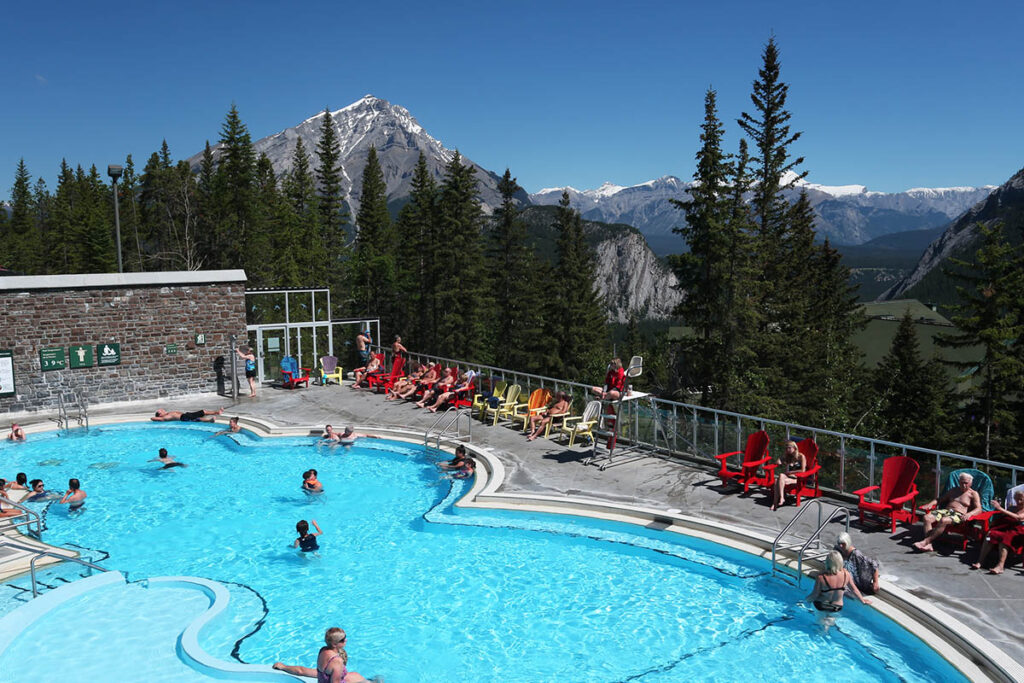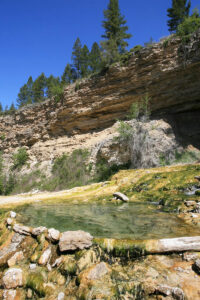What are the Best Hot Springs in the Canadian Rockies?
The best hot springs in the Canadian Rockies come in two different types—hot springs that have been commercialized and hot springs left in their natural state.
Canadian Rockies hot springs are particularly stimulating in winter, when edged by snow and covered in steam—your head is almost cold in the chill air, but your submerged body melts into oblivion. The Eclipse Nordic Hot Springs are in the Yukon, a long way from the Canadian Rockies, but on the coldest days of winter you’ll often see Canadian Rockies swimmers with hairstyles similar to the Eclipse’s Hair Freezing Contest.
Banff National Park was established primarily because of the Cave and Basin Hot Springs, which was discovered in 1883. This hot springs is now open as a museum but closed for swimming. Nearby is BANFF UPPER HOT SPRINGS (year-round), on the slopes of Sulphur Mountain above the town of Banff. First developed in 1901, the present building was completed in 1935, with extensive renovations made in 1996. Water flows out of the bedrock at 47°C (116.6°F) and is cooled to 40°C (104°F) in the main pool. Once considered for privatization, the springs are still run by Parks Canada and are popular throughout the year.

Banff Upper Hot Springs
In Jasper National Park, MIETTE HOT SPRINGS (mid-May to mid-October) is the warmest springs in the Canadian Rockies. In the early 1900s, these springs were one of Jasper National Park’s biggest attractions. In 1910, a packhorse trail was built up the valley, and the government constructed a bathhouse. The original hand-hewn log structure was replaced in the 1930s with pools that remained in use until new facilities were built in 1985. Water that flows into the pools is artificially cooled from 54°C (128°F) to a soothing 39°C (100°F). A newer addition to the complex is a smaller, cool plunge pool.
RADIUM HOT SPRINGS (year-round) lie at the southwest corner of Kootenay National Park.
The piping hot water is diverted from its natural course into the commercial pools, including one that is Canada’s largest. Steep cliffs tower directly above the hot pool, whose waters (39°C/97°F) are coloured a milky blue by dissolved salts, which include calcium bicarbonate and sulfates of calcium, magnesium, and sodium.

Natural hot springs at Fairmont.
Unlike the three Canadian Rockies hot springs described above, which are operated by Parks Canada, FAIRMONT HOT SPRINGS RESORT is a privately owned operation. Located south of Invermere along Highway 93/95, the pools are part of a much larger development that includes residences, golf courses, a ski hill, and a strip mall. The appeal of Fairmont Hot Springs is simple—unlike most other springs, the hot water bubbling up from underground here contains calcium, not sulfur with its attendant smell.
Best known of Canadian Rockies hot springs left in their natural state is LUSSIER HOT SPRINGS, east of Canal Flats on Hwy 93/95 in Whiteswan Lake Provincial Park. Here two small pools have been constructed to contain the odorless hot (43°C/110°F) water as it bubbles out of the ground and flows into the Lussier River. Access is down a steep trail. Another lesser-known spot is downstream from Fairmont Hot Springs Resort, where pools are filled by a waterfall of mineral water.
